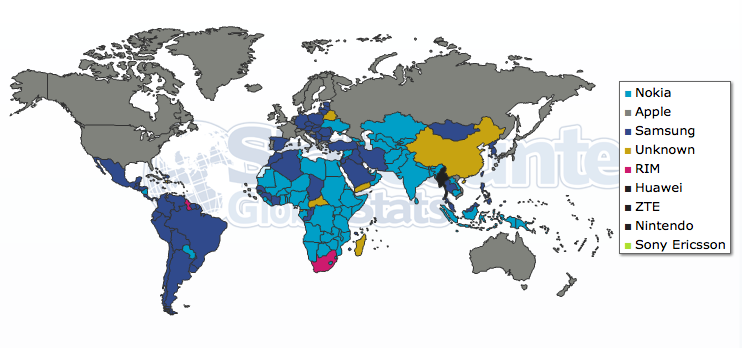Samsung has extended its global lead over Apple when it comes to which mobile devices people use to access the Internet, according to the latest numbers from web analytics provider StatCounter.
That lead may not last long, of course, given Apple’s coming iPhone launches.
But as of August 2013, Samsung phones and tablets accounted for 25.7 percent of all global mobile web traffic, continuing the lead the company captured in June. Apple, which is just about to launch a lower-cost iPhone, is responsible for 23.4 percent of all global Internet traffic, while Nokia, which still led as late as December of 2012, sunk to third place with 21.7 percent.
 More interesting, however, is the global distribution.
More interesting, however, is the global distribution.
Apple owns much of the northern hemisphere, with a leading share in Canada, US, Russia, Northern Europe, and France, Italy, and the UK. The southern hemisphere is divided between Nokia, the incumbent with still-strong share in Africa, plus some more northern footholds in Central Asia, and the global champion, Samsung, which owns South America, plus much of central Europe, and Asia.
Australia and Vietnam are Apple’s only southern footholds.
Clearly, there’s a major division between richer “first-world” countries and poorer “third-world” countries, particularly in Africa, where Nokia’s cheap feature phones are still doing well. Apple’s highest webshares are in Australia, at 66 percent, and Canada, at 63 percent. The U.S. is 52 percent Apple, and even Nokia’s native Finland is 35 percent Apple to only 25 percent Nokia. Samsung rules South America, with 36 percent of Brazil, and gets some of its highest market share in Northern Africa and Central Asia, with 47 percent share in Iraq.
The question is, what will Apple’s new, cheaper iPhone 5C do to this picture? Apple will be releasing it at a special event tomorrow in Cupertino.
“Over the past 12 months, Apple has increased its share in the US and UK, but globally there is an ongoing battle taking place between it and Samsung,” said StatCounter CEO Adodhan Cullen in a statement. “Should the rumors prove true, it will be fascinating to see if a less expensive iPhone will help it increase market share against lower cost competitors in global markets.”
Apple’s big challenge, if it wants to make that happen, is to make itself relevant in the less wealthy countries, where its current phones are simply too expensive. That’s especially the case in China, which is buying more smartphones than any other country in the world right now — almost three times as many as the U.S. Apple’s new iPhone 5C could help here — as could a new deal that Apple seems to have signed with the biggest mobile carrier in the world, China Mobile, which has over 700 million subscribers.
India is another challenge for Apple, where it only has 1 percent of mobile web traffic, to 27 percent for Samsung.
What about former global smartphone leader BlackBerry?
There are still two countries in the world where the dying smartphone company is in the lead: South Africa, at 41 percent, and the tiny South American country of Guyana, at 25 percent. BlackBerry has lost massive share in the past years and is currently seeking an outside buyer for the company’s assets.
VentureBeat's mission is to be a digital town square for technical decision-makers to gain knowledge about transformative enterprise technology and transact. Learn More


